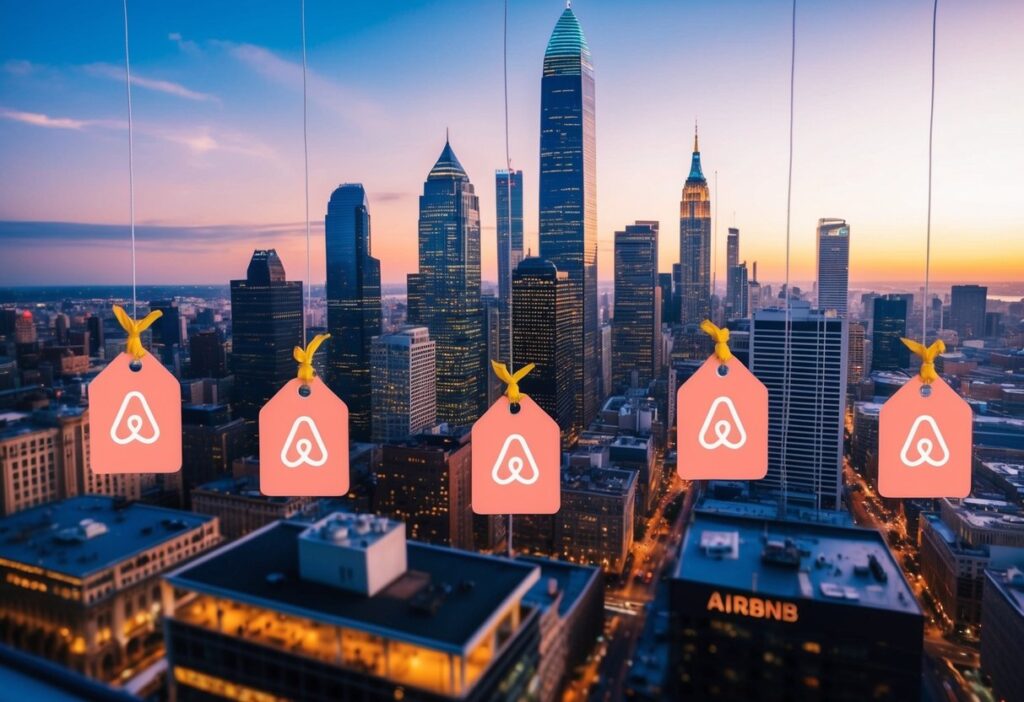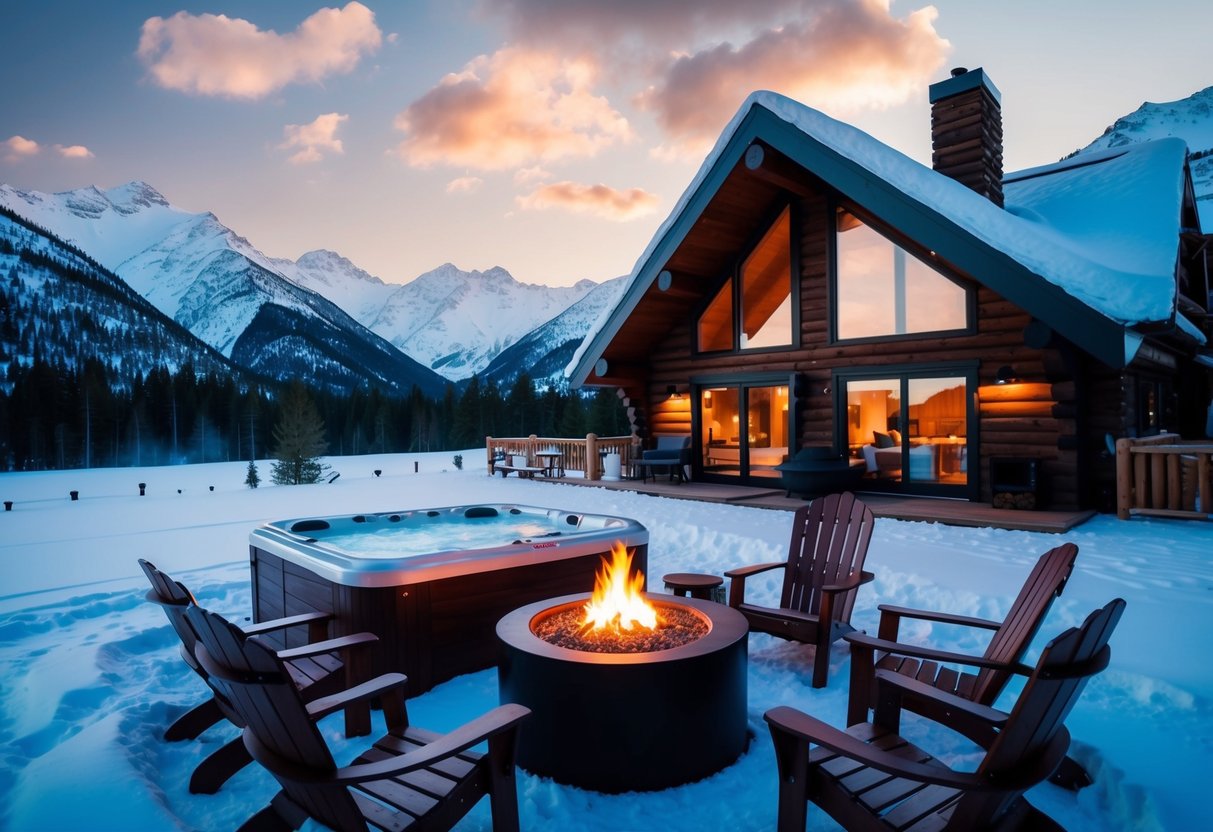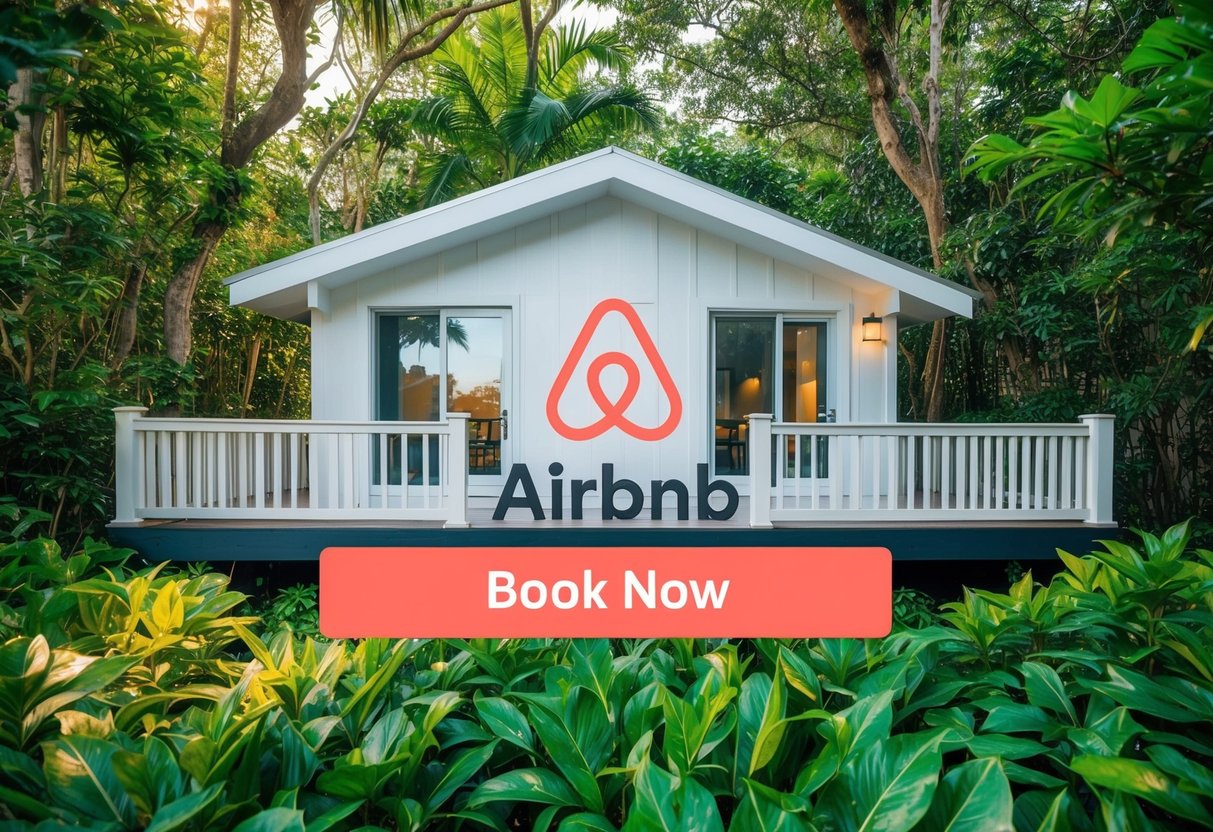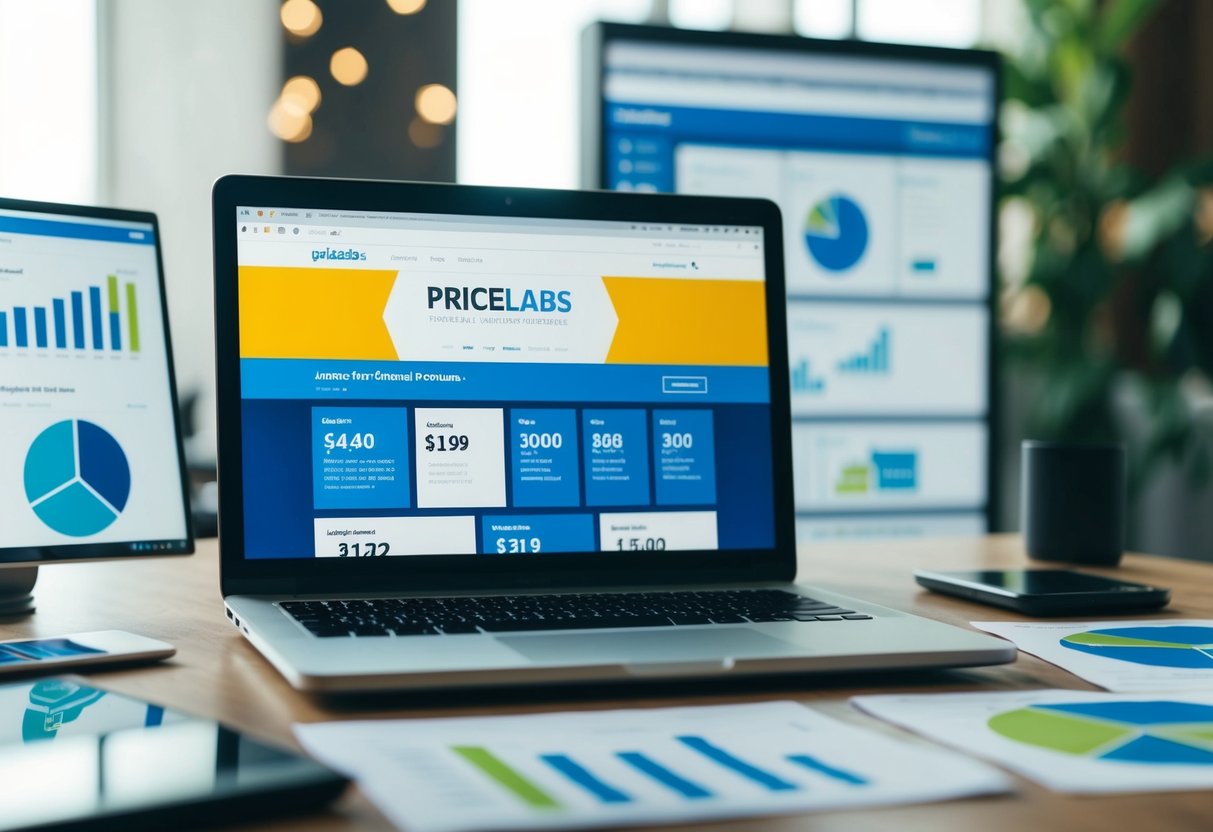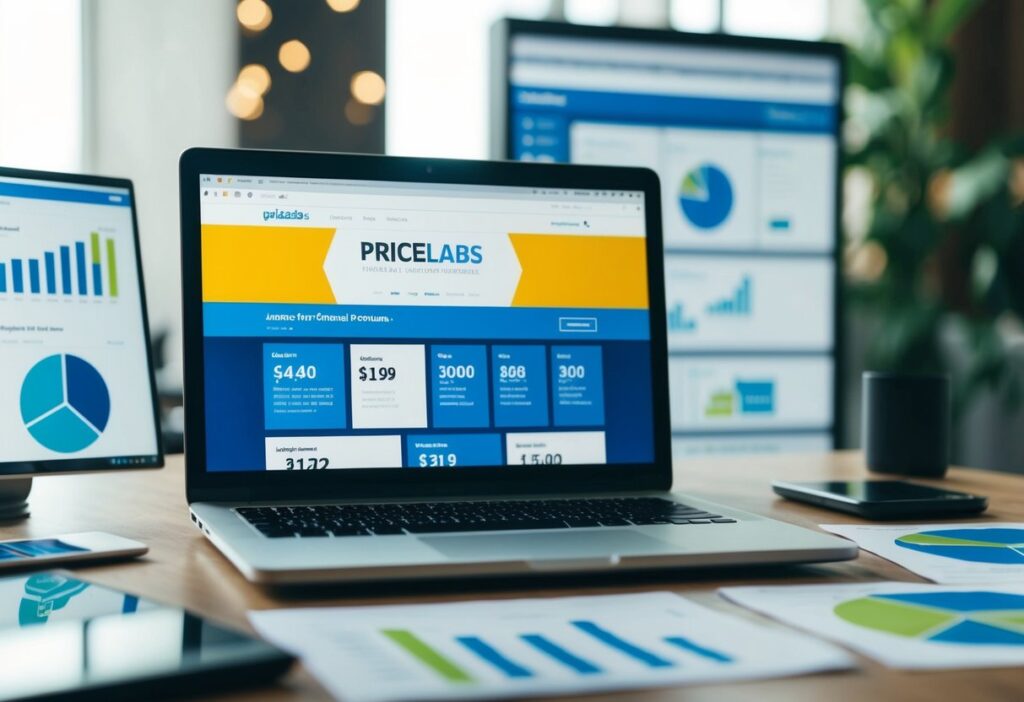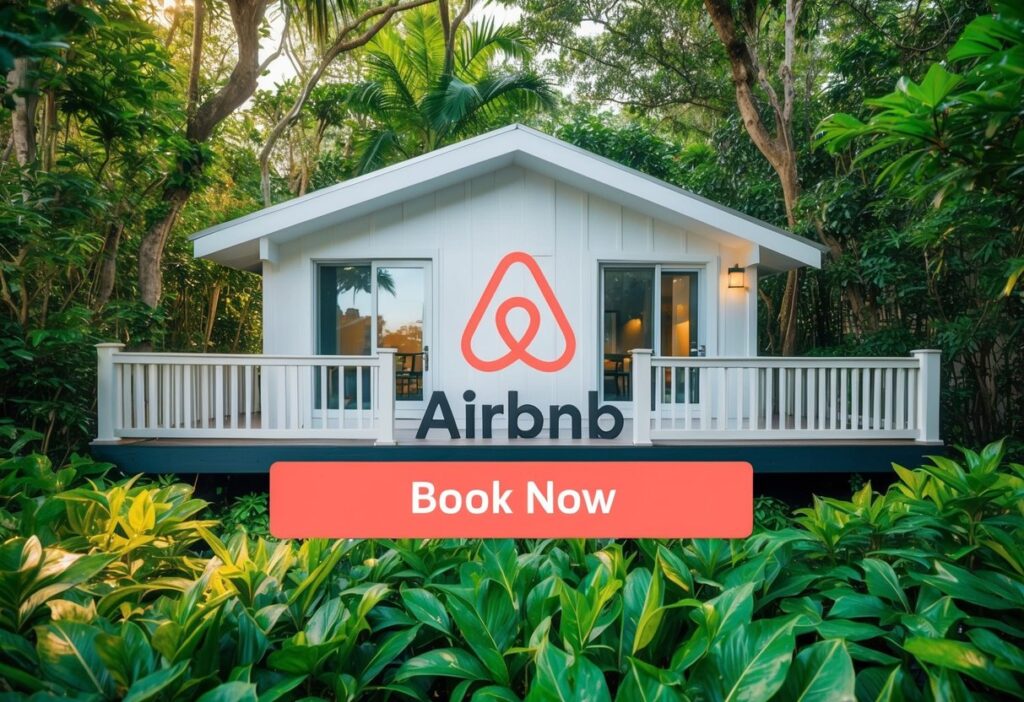Still winging your Airbnb pricing strategy? That’s a fast track to leaving serious money on the table. In the world of Airbnb, pricing isn’t just a number—it’s a game plan. And if you’re not using it to your advantage, someone else definitely is.
Your price needs to do more than cover operational costs and hope for bookings. It should reflect demand, outsmart your competition, and flex with the seasons. From peak weekends to low season, every night is a chance to optimize—and cash in.
This guide unpacks 20+ proven Airbnb pricing strategies that both new and seasoned Airbnb hosts can use to level up. By the end, you’ll confidently set rates, adapt to trends, and manage your Airbnb like a pro.
Ready to turn your listing into a money-making machine? Let’s break it down.
Key Takeaways:
- Leverage Dynamic Pricing Tools: Automate rate changes using real-time market data points. Also, add manual pricing insights for a strong hybrid pricing strategy.
- Use Advanced Strategies All Year: Set minimum rates, adjust prices by the day, and employ specific strategies for each channel to stay competitive during regular seasons.
- Maximize Early Reviews’ Impact: With less than 10 reviews, Airbnb’s Smart Pricing can help. Try undercutting competitors or waiving cleaning fees. This can boost visibility and attract attention quickly.
- Raise Rates in Busy Times: Take advantage of high-traffic periods by increasing prices, setting minimum stay rules, and adding last-minute fees to boost premium bookings.
- Stay Profitable in the Off-Season: Keep income steady with long-stay discounts, early bird deals, and promotional pricing for slower travel months.
Leverage Dynamic Pricing Tools (Beyond Airbnb Smart Pricing)
To set the right Airbnb pricing strategy for your listing, don’t just trust your gut. Guessing won’t work. Enter dynamic pricing tools—the game-changer every savvy host needs. These tools change your nightly rates automatically. They use real-time data points like local demand, market trends, seasonal demand, and competitor pricing. This way, you stay ahead of the competition. Consider them your personal pricing gurus. They work hard to boost your earnings, so you can focus on what you do best—welcoming guests.
What Are Dynamic Pricing Tools?
Dynamic pricing tools use a lot of market data. They update your nightly rates all the time. Dynamic pricing tools change rates based on supply and demand, unlike static pricing. This means you can always charge the best price according to real-time market conditions. These tools adjust your pricing, so you can maximize your earnings. Whether it’s a busy holiday weekend or a quiet Tuesday night during the low season, they always adapt.
Dynamic pricing tools are vital for Airbnb hosts. They help both individual property owners and property managers stay competitive and boost earnings. PriceLabs says that hosts who use dynamic pricing make 26% more revenue on average. Dynamic pricing helps hosts and property managers adapt to market changes. It’s a major upgrade for anyone running an Airbnb business.
Why Third-Party Pricing Tools Outperform Airbnb Smart Pricing
Airbnb’s Smart Pricing is useful, but it often fails to optimize rates for maximum revenue. Airbnb’s algorithm aims to boost calendar bookings and maximize occupancy. It does not prioritize earning more per booking. It uses a basic method to set rates based on local demand. However, it overlooks competitor prices, new trends, and broad market signals.
That’s where third-party dynamic pricing tools excel. These platforms optimize for revenue, not just occupancy. They use real-time competitor rates, historical trends, and booking date insights. They also consider booking lead times and local events. Their smart algorithms analyze this data. They find the best nightly rate for your listing–be it a discounted rate or a premium price. This lets you earn more while keeping your bookings, even when the market shifts quickly.
Benefits of Advanced Third-Party Pricing Tools
A third-party dynamic pricing tool can change your hosting strategy in many ways:
- Customization Flexibility: You can create custom pricing rules, something Airbnb’s Smart Pricing can’t match. Want to set a minimum price based on competitor rates or historical trends? Or run promotional pricing for last-minute bookings? Dynamic pricing tools help you gain control over your revenue. They let you stay competitive without losing profits.
- Save Time and Stay Competitive: Pricing tools update daily or even many times a day. This keeps you in sync with the market. You won’t miss opportunities or deal with outdated rates.
- Multi-Property Management: If you have multiple properties, dynamic pricing tools can change rates for all your properties at the same time. This makes it easy to handle pricing changes across many properties. No more manually checking each listing and tweaking prices.
Dynamic pricing tools like Beyond, PriceLabs, or Wheelhouse do more than adjust numbers. They help you master profitable, data-driven pricing. These systems keep your listing visible and booked. This happens even when market conditions change.
Ready to step up your pricing game? These tools are your ticket to dominate your short-term rental business—and boost profit like a pro.
Advanced Airbnb Pricing Strategies
For seasoned hosts and property managers, pricing is more than a strategy—it’s an art. Mastering advanced Airbnb pricing strategies can boost your revenue. It helps keep your vacation rental competitive while still making a profit. Ready to level up? Let’s explore smart pricing strategies. It’s key for boosting profits and keeping your expenses in check.
Strategy #1: Set a Rock-Solid Minimum Acceptable Rate
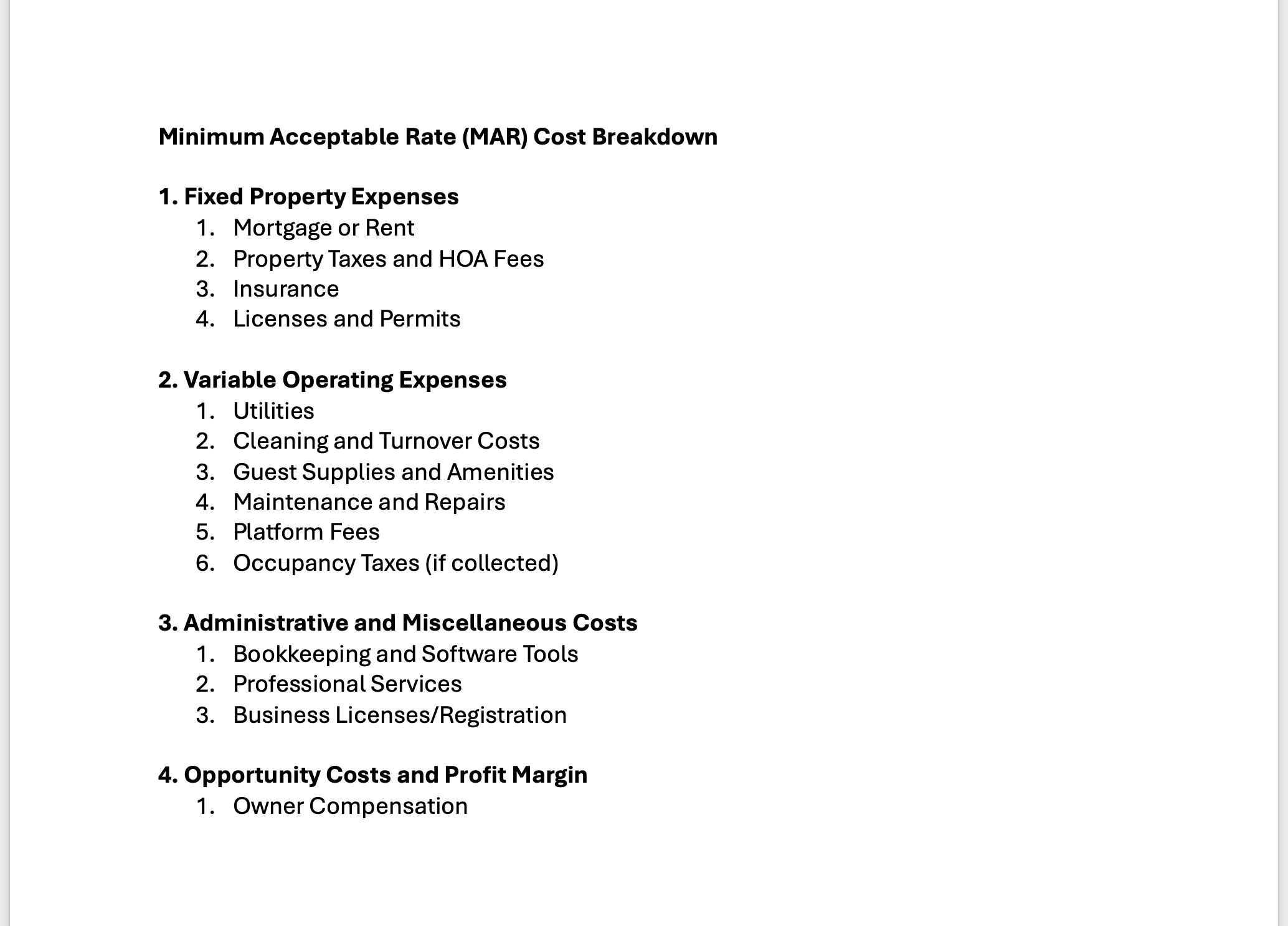
Make sure your Minimum Acceptable Rate (MAR) includes all costs
A key dynamic pricing strategy for experienced Airbnb hosts is the minimum acceptable rate (MAR). This is your non-negotiable baseline price. You won’t go below it, no matter how tempting the competition is. Think of it as your financial safety net. It helps cover your nightly costs, even during the low season when demand drops.
Setting a solid MAR helps you stay profitable. It keeps you from being unprofitable just to get bookings. It also prevents you from joining a pricing war with other listings. This helps keep your margins safe. A clear MAR serves as your pricing anchor. It lets you adjust prices based on market changes while protecting your profits.
🔥 Why This Works: With your MAR in place, you protect your profits from market fluctuations. Your base rate keeps your vacation rental financially healthy, even with discounts or promotions. It’s your safeguard against undervaluing your property while still staying competitive on the Airbnb platform.
✨ Pro Tip: Include costs for cleaning and utilities to find your break-even point. Then, add a buffer for any unexpected monthly expenses. You can use that number to set your MAR in your pricing tool or on Airbnb. This helps ensure you stay profitable in the long run.
Strategy #2: Use Orphan Gap Pricing to Boost Occupancy
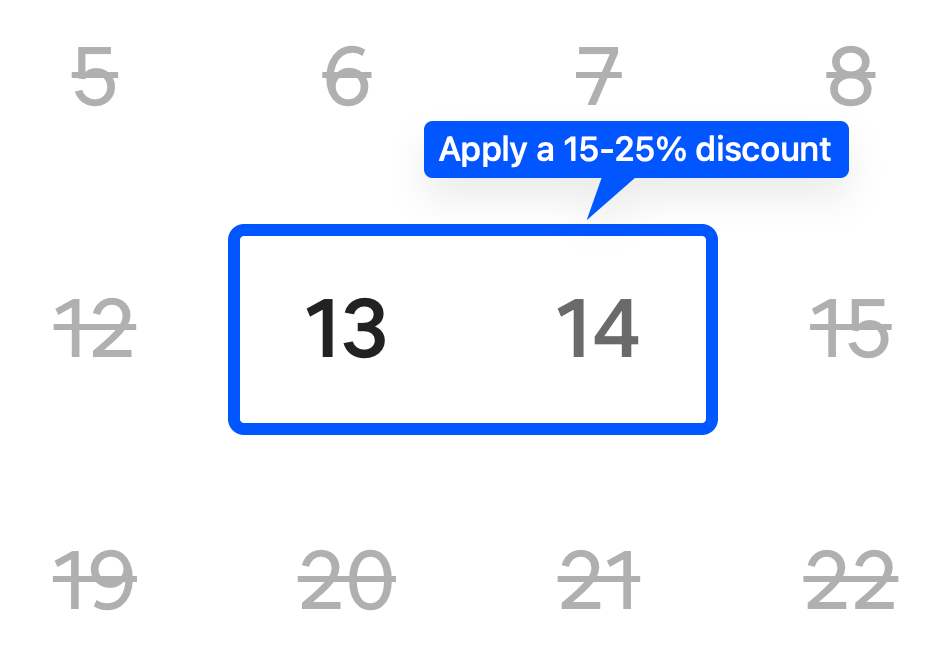
Orphan gaps can be difficult to fill unless a discount is offered
Ever notice those annoying gaps between bookings? They’re often money left on the table. Enter orphan gap pricing: a smart Airbnb pricing strategy that fills empty dates with lower rates. This attracts last-minute guests, especially those staying for one or two nights.
This strategy maximize occupancy without slashing your overall rates. It’s perfect for filling in short intervals and maximizing your calendar’s potential. A discount on those odd dates can help capture that demand and keep your space occupied.
🔥 Why This Works: Orphan gap pricing increases occupancy. It does this without lowering your nightly rates for longer stays. It cuts down on empty nights, increases your profits, and raises your listing’s rank on Airbnb. More bookings lead to more visibility.
✨ Pro Tip: Check for overlooked single- or two-night gaps in your calendar—these are your sweet spots. You can manually adjust rates for these days or automate them through your pricing tool. Keep an eye on booking trends to see if last-minute guests are taking those discounted spots. Consistency is key—keep your calendar full and your revenue high!
Strategy #3: Channel-Based Pricing to Attract Direct Bookings
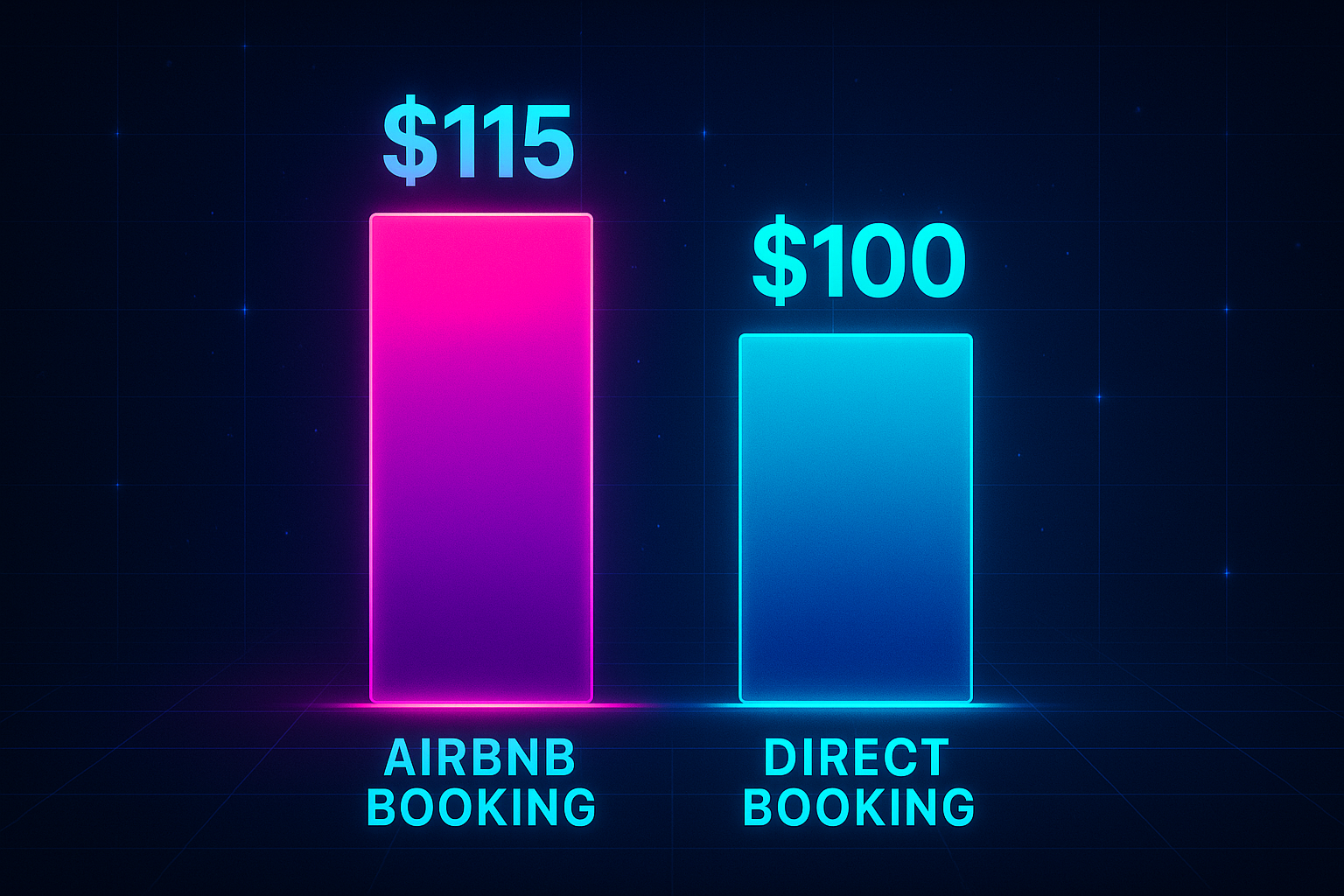
Channel-based pricing
Want to keep more of your hard-earned cash? Channel-based pricing is your answer. Change your Airbnb prices. This way, guests will book through your website or another direct channel. This way, you cut out the middleman and avoid platform fees. These fees can take up to 15% of your profits.
This strategy helps you increase revenue. It also makes your listing stand out from the competition. Offering a better deal for direct bookings helps you build stronger guest relationships. You also get more bookings. Plus, guests who book directly are more likely to return, helping you build a loyal customer base.
🔥 Why This Works: The magic of channel-based pricing is all about maximizing occupancy. With better rates, guests are more likely to book. You also create a chance for repeat guests. By giving them perks or loyalty rewards, you encourage them to stay again.
✨ Pro Tip: Set your Airbnb rate a little higher than your direct booking rate. This encourages guests to book directly. Mention the perks of booking on your website.
Strategy #4: Day-of-the-Week Pricing Adjustments
Timing matters in Airbnb pricing. Day-of-the-week adjustments help you set your rates based on local demand. Business travelers usually book trips during the week. In contrast, leisure travelers often choose weekends for their getaways.
Local events like conferences or festivals can also affect demand, particularly on weekends. Adjust your pricing based on trends to boost your earnings. Charge more on busy days and lower rates when occupancy is low.
🔥 Why This Works: Day-of-the-week pricing lets you raise prices when demand is high. This often happens on weekends or during events. It also keeps prices lower on slower days, such as Mondays and Tuesdays. Airbnb says that lowering minimum stay rules and adding discounts in slow seasons can help you book more rooms. This strategy attracts last-minute and shorter bookings when demand is low.
✨ Pro Tip: First, look at your past booking data. Find out which days of the week have the highest occupancy. If Thursdays to Saturdays are the busiest days in your market, then raise prices. Dynamic pricing tools automate price changes. This keeps your pricing in line with market demand, so you avoid the hassle of manual updates. Regularly check your pricing. Seasonality and changing traveler habits can affect demand. Stay flexible. Adjust your strategy to keep up with market trends. This helps you stay profitable.
Airbnb Pricing Strategies for Listings with Less Than 10 Reviews
Starting with fewer than 10 reviews on Airbnb is hard. However, a smart pricing strategy can help you gain traction. The goal is to attract bookings, earn those first 5-star reviews, and rise up the search rankings.
Set your pricing correctly from the beginning. This way, you’ll gain credibility, build loyalty, and ensure long-term success.
Strategy #5: Undercut Competitors for Initial Traction
Starting a new Airbnb listing with few reviews can be tough, but a simple strategy can give you the edge. To attract budget-conscious guests, offer lower prices than similar listings nearby. This strategy can help you get those important first 5-star reviews. This increases your visibility and builds trust. As a result, you succeed faster on the platform.
🔥 Why This Works: Lowering your nightly rate makes your listing more appealing to budget travelers. This boosts your chances for early bookings and good reviews. So, it helps improve your spot in Airbnb’s search results. More reviews mean more visibility. This helps you slowly increase your rates as your reputation improves.
✨ Pro Tip: To implement this strategy, carefully do a market research of your competitors. Check listings with similar features. Set your base price 15-25% below the market average. Don’t go too low—ensure your pricing still covers costs and offers value to guests. Once you get 5 to 10 positive reviews, begin to raise your rates gradually. Don’t raise them all at once—track how guests respond and adjust your prices based on your booking pace. This will help solidify your listing’s reputation and allow for a gradual price increase.
Strategy #6: Activate Airbnb Smart Pricing for Increased Visibility
Airbnb Smart Pricing is a handy tool. It changes your nightly price automatically. It looks at market demand, the time of year, and Airbnb’s pricing algorithm. It’s perfect for new hosts. You can easily manage pricing. There is no need to dive into complex strategies.
Activating Smart Pricing boosts your ranking on Airbnb. This is important if you have few bookings and limited reviews. It’s a great stepping stone before you move on to advanced automated tools. Hosts have seen their booking prices increase by an average of 7% and their occupancy rate jump to 92%.
🔥 Why This Works: Smart Pricing boosts your search visibility. This is great if you’re still building your reputation. It adjusts your pricing based on market trends. This keeps you competitive without any extra effort. This lets you get bookings, even if you have few reviews at first.
✨ Pro Tip: To start, turn on Smart Pricing in your Airbnb dashboard. Set a minimum nightly rate to protect your earnings. Check how often your listing shows up in searches. Adjust the maximum price limit to keep your rates competitive. After getting 10 reviews, it’s best to use third-party dynamic pricing tools. This helps you maximize revenue.
Strategy #7: Short Minimum Stay to Build Reviews Fast
When you start on Airbnb, getting good reviews is key. They help build your credibility and improve your search ranking. One powerful way to accelerate this process is by offering short minimum stays—think 1 or 2 nights. This strategy makes it easier for travelers to book quick getaways. Weekend trippers and last-minute bookers can jump in easily. As a result, your booking volume will rise. More bookings lead to more chances to impress guests. This helps you gather valuable reviews and quickly build your social proof.
🔥 Why This Works: Short minimum stays attract many guests. They appeal to those wanting a quick getaway or booking last minute. As your guest count grows, the number of reviews increases. This boosts your listing’s visibility and appeal to future guests.
✨ Pro Tip: In your Airbnb settings, reduce the minimum night stay to 1 or 2. Monitor the number of reviews you gather and the impact on your star rating. After getting at least 10 reviews, review your strategy. Adjust your pricing and stay policies to keep your success going.
Strategy #8: Reduce or Eliminate Cleaning Fees
Cleaning fees can really disappoint budget travelers. This is especially true if they cost almost like the nightly rate. When you’re just starting out with a new Airbnb listing and have few reviews, every little bit of value counts. Lowering or removing cleaning fees boosts your listing’s value. It also helps it stand out from other hosts with higher fees.
It also promotes shorter stays. This can help you get more reviews and improve your visibility. The average cleaning fee on Airbnb ranges from $50 to $80. But if you charge $70 for a one-night stay, it might seem high.
🔥 Why This Works: Reducing or removing the cleaning fee cuts an extra cost for guests. This change can attract budget travelers. This makes your listing more appealing to more guests. It’s great for those seeking a quick, budget-friendly escape.
✨ Pro Tip: Check your cleaning fee in the Airbnb pricing settings. Think about lowering or removing it for the first few months. In your listing description, clearly state that there is “No cleaning fee” to make it a selling point.
Strategy #9: Offer Flexible Cancellation to Encourage Bookings
When your Airbnb listing is new, guests might hesitate to book. They want to see reviews first. After all, booking a stay at an unfamiliar property feels risky. A flexible cancellation policy reduces their worries and boosts your booking rate.
If competitors have strict cancellation policies, your flexibility gives you an advantage. This strategy is great for early bookers. It cuts down on friction and helps them pick your place easily.
🔥 Why This Works: A flexible cancellation policy reduces risk for potential guests. This makes them more likely to book. It’s very important when you’re starting out and have little credibility. Guests are more likely to book your property if they know they can cancel easily if their plans change.
✨ Pro Tip: Go to your Airbnb dashboard. Then, choose the “Flexible” cancellation policy to begin. Highlight this in your listing description. Let guests know they can book with confidence. Keep an eye on your cancellation rates—if they start to rise too much, you can always adjust. After getting more positive reviews, you can think about a stricter policy if it fits your goals.
Advanced Airbnb Pricing Strategies for Peak Season
When peak season hits, it’s time to step up your pricing game. During busy times, like holidays, local events, or summer, guests will pay more. Your competitors are ready to do the same. To make the most of this prime opportunity, you need more than just basic pricing strategies.
Use advanced seasonal pricing strategies such as calendar blocking, gradual price increase, last-minute markups, and more. These methods help your listing stand out, boost profits, and keep your calendar full. Let’s dive into the smart, savvy ways to adjust your rates and make this peak season your most profitable yet!
Strategy #10: Block Your Calendar, Then Release Dates Last-Minute
Use this bold pricing strategy that taps into psychology and market trends: block your calendar during busy times. Then, jump in when demand is high and availability is low. Most hosts hurry for early bookings. But this different approach helps you take advantage of scarcity.
You can raise your listing price when competitors fill their spots for big events, holidays, or busy weekends. It’s great for travelers who plan at the last minute. 56% of European travelers book last-minute stays. This shows a strong group willing to pay a premium when choices are limited.
🔥 Why This Works: It meets a strong demand where urgency matters more than price. Guests who have fewer options tend to book faster and pay more. This makes your listing seem like a great find. This strategy shines in markets with low inventory during busy times. It helps your place stand out as a hidden gem that appears right when needed.
✨ Pro Tip: Block out those key dates on your calendar. Watch your competitors. When their calendars get busy, announce your dates. Increase your nightly rate. Update your listing to show your last-minute openings. Phrases like “just became available!” or “rare last-minute opening” can drive bookings from guests eager to secure a spot.
Strategy #11: Gradually Raise Prices as Occupancy Grows
This strategy is all about timing and tuning your prices to the rhythm of demand. Start peak season with a slightly lower nightly rate to lock in early birds who like to book ahead. Once you get reservations and your calendar fills up, start raising your prices. Early bookings give your listing a boost. They show social proof. As your availability decreases, higher prices seem more justified.
This approach works well for hosts who watch occupancy closely. It helps them balance filling their calendar and maximizing profit. Think of it like surfing a pricing wave in peak season—beginning small, but ending strong.
🔥 Why This Works: You enjoy early guaranteed bookings. Plus, you can charge more when demand rises. Guests booking later typically have fewer choices and are more willing to pay extra. Adjusting prices as bookings come in makes each night more valuable than the last.
✨ Pro Tip: Set occupancy milestones. For example, raise your rate by 5–10% after booking 50–60% of your calendar. You can automate this with a dynamic pricing tool or do it manually if you prefer hands-on control. Watch your booking pace. If dates fill up fast, it’s a clear sign to raise prices more. Keep an eye on your competitors. Your rates should match demand. But don’t set them higher than similar listings nearby.
Strategy #12: Capitalize on Premium Weekend and Local Event Surges
Weekends and local events are goldmines for Airbnb. Picture sold-out concerts, crowded stadiums, buzzing food festivals, or tech conferences attracting thousands. High-traffic times mean travelers expect to pay more. If you don’t take advantage of this, you’ll miss out. Smart hosts plan ahead by identifying major weekends and bumping up rates accordingly. Travelers often spend extra for convenience and location. This is especially true on busy Saturdays or during major events.
This strategy can boost your revenue without much extra work. The key is to stay ahead of the demand curve—and position your place as the go-to option when the city fills up.
🔥 Why This Works: Guests who book during major events or busy weekends expect higher prices. In fact, they often feel relieved when they find a well-located listing that hasn’t been scooped up. This strategy allows you to charge the true value of your listing when demand is highest. This can greatly increase your earnings.
✨ Pro Tip: Check your local events calendar for the next 6+ months. Look for parades, conventions, seasonal festivals, sporting events, and concerts. Set a higher weekend rate in advance, and for especially big events, add a “surge” on top. Update your listing description. Highlight how close you are to the venue. This helps make your higher rate feel justified and more appealing to event-goers.
Strategy #13: Enforce Targeted Minimum Stay Requirements
When demand is high, it’s time to stop catering to one-nighters. Minimum stay rules can increase your earnings. They also lower the stress from frequent turnovers. Consider holiday weekends, big festivals, or busy summer days. These are ideal times to ask guests to stay for 5 to 7 nights. Why? Because longer stays mean fewer cleanings, less guest communication, and more consistent income.
Also, travelers at multi-day events plan to stay longer, so make it worth their time, too. It’s a smart move for hosts. They can cut burnout and increase profits during busy calendar times.
🔥 Why This Works: Longer stays during busy times boost your average booking value. This also helps lower cleaning costs and reduces operational churn.
✨ Pro Tip: Go to your Airbnb calendar. Set a custom rule for a 5–7 night minimum stay during busy times like holidays, festivals, or long weekends. Combine it with a weekend rate bump for even more impact. If bookings slow down, don’t panic—just adjust the rule or offer a small discount to fill gaps. Flexibility is key, but starting with longer stays gives you the upper hand.
Strategy #14: Last-Minute Markups to Maximize Gap Nights
Let’s discuss procrastinators. They plan at the last minute, travel spontaneously on weekends, and belong to the “we’ll figure it out later” group. These guests account for a big part of Airbnb bookings. And when they’re down to the wire with few options left? That’s your golden opportunity. By raising your nightly rate just 5–7 days before check-in, you tap into their sense of urgency.
It’s the classic supply-and-demand play: fewer options mean higher prices. Travelers in a hurry often pay extra to secure a booking. That booking could be your listing.
🔥 Why This Works: You’re not just pricing for the room—you’re pricing for peace of mind. Last-minute guests often have limited options and feel more stressed. This leads them to book quickly, even if prices are higher. That translates to higher revenue without any extra effort.
✨ Pro Tip: Keep a close eye on your calendar. If you see gap nights 5–7 days before arrival in a busy period, raise the price by 10–20% or more, based on competition. In your listing, mention that “limited availability” or “high demand dates” are driving up prices. This shows why the premium is justified. And if bookings don’t bite? No shame in dialing the price back slightly. You’re running a business, not gambling—so stay agile.
Strategy #15: Leverage Early Bird Premiums for Forward-Planners
Not every traveler books at the last minute. Some plan ahead with color-coded calendars and countdowns to their vacations. And these guests? They’re ready to pay a little extra to secure the perfect stay well in advance. That’s where your early bird premium comes in. Raising the base price for bookings over 3 months ahead does more than increase revenue. It also creates a sense of value.
It’s a win-win: they get peace of mind, and you get money in the bank (and one less calendar slot to worry about).
🔥 Why This Works: Early bookers are often planners who value peace of mind over rock-bottom prices. They’re willing to pay more to secure a high-quality stay during popular travel periods, especially when booking trips tied to holidays, events, or school breaks. By charging a premium for reservations made 90+ days in advance, you appeal to their desire for certainty while boosting your early revenue. It also helps you gauge demand early, smooth out cash flow, and fine-tune your pricing as the date approaches.
✨ Pro Tip: Head to your pricing settings and raise rates for dates 90+ days out. Combine this strategy with a flexible cancellation policy. This will help early guests feel more confident about their commitment. And if occupancy is looking soft closer to the date? Just scale prices down accordingly. This way, you lock in early premiums while staying competitive as the season unfolds.
Advanced Airbnb Pricing Strategies for Off-Season
The off-season often gets a bad name. But for smart hosts, it’s the best time to show off their pricing skills. With fewer travelers and empty calendars, be sharper, smarter, and more creative. This is where advanced strategies matter. They help keep bookings coming in and allow you to thrive while others scramble.
Help remote workers find peace or travelers score deals? These tips will keep you ahead as demand drops. Let’s make the off-season your secret weapon.
Strategy #16: Implement Gradual Price Reductions for Slower Demand
Off-season doesn’t have to mean off-limits. During peak season, travelers flock to your site. But in slower months, you need a bit of skill. Don’t cut your nightly rates like it’s a clearance sale. Instead, try gradual reductions. This approach is more strategic and can be more profitable.
The idea is simple: gradually lower your price bit by bit. This helps encourage bookings without showing desperation. This Airbnb pricing strategy helps you find options. It keeps you visible in searches and draws in guests looking for deals. Plus, it keeps your margins intact.
🔥 Why This Works: Gradual price drops help you stay competitive and protect your value. It also lets you check the booking climate. This way, you can make smart pricing choices instead of acting on impulse. Plus, you can stay booked without diving straight into rock-bottom pricing.
✨ Pro Tip: Keep an eye on booking trends as the off-season kicks in. Start by trimming your price by 5–10% every other week until you see a lift in inquiries or bookings. Use tools or look at competitor insights to see where the market is going. Also, keep an eye on your occupancy rate to assess the impact. Think of it as tuning your pricing dial instead of smashing the panic button.
Strategy #17: Adopt Ultra-Competitive Rates to Stay in the Game
When travel slows and your inbox is quiet, it’s time to get serious. Offer very competitive pricing. Think of it as your listing’s winter coat: it keeps you warm (with bookings) even when demand chills. Offering bigger discounts during slow times might not sound thrilling, but it helps keep your schedule busy.
This strategy keeps you active in Airbnb search results. It helps you cover fixed costs, collect reviews, and stay visible when others drop out.
🔥 Why This Works: In the off-season, every booking counts. Lowering your rate can help you stand out when guests are few and competition is tough. It also keeps your listing relevant. Airbnb favors active, booked listings in search rankings.
✨ Pro Tip: Do some local market recon—see what similar listings are charging, and go slightly lower. Use a dynamic pricing tool. It keeps your rate updated automatically. This happens based on market trends. Once bookings start rolling in, nudge your price up slowly. Remember, off-season is a volume game—you win by staying booked, even if it means smaller wins per night.
Strategy #18: Extend Weekly and Monthly Discounts

Show available discounts clearly in your gallery images as well as in your listing description
When the weekend crowd leaves and tourist traffic drops, focus on your off-season MVPs: extended-stay guests.
Digital nomads looking for a change and snowbirds escaping winter can find discounts on weekly and monthly stays. These offers can help keep your calendar busy. These guests swap short stays for longer, quieter ones. You’ll have fewer turnovers, less cleaning, and much more predictability. Plus, who doesn’t love locking in a few weeks (or months) of income in one go?
🔥 Why This Works: Fewer check-ins reduce chaos. Longer stays provide steady income without the need to find new guests constantly. It’s a win-win for hosts who prefer peace of mind over nightly volatility.
✨ Pro Tip: Go to your pricing settings. Create custom discounts: 10-20% for weekly stays and up to 20-30% for monthly stays, as advised by hospitality experts. Show off your property’s remote work perks. Mention strong Wi-Fi, a dedicated workspace, and a coffee maker. Guests want comfort and convenience in long-term rentals. So, make sure your listing highlights these features clearly. Then sit back, relax, and let your place work for you, week after week.
Strategy #19: Cater to Corporate Guests and Business Travelers
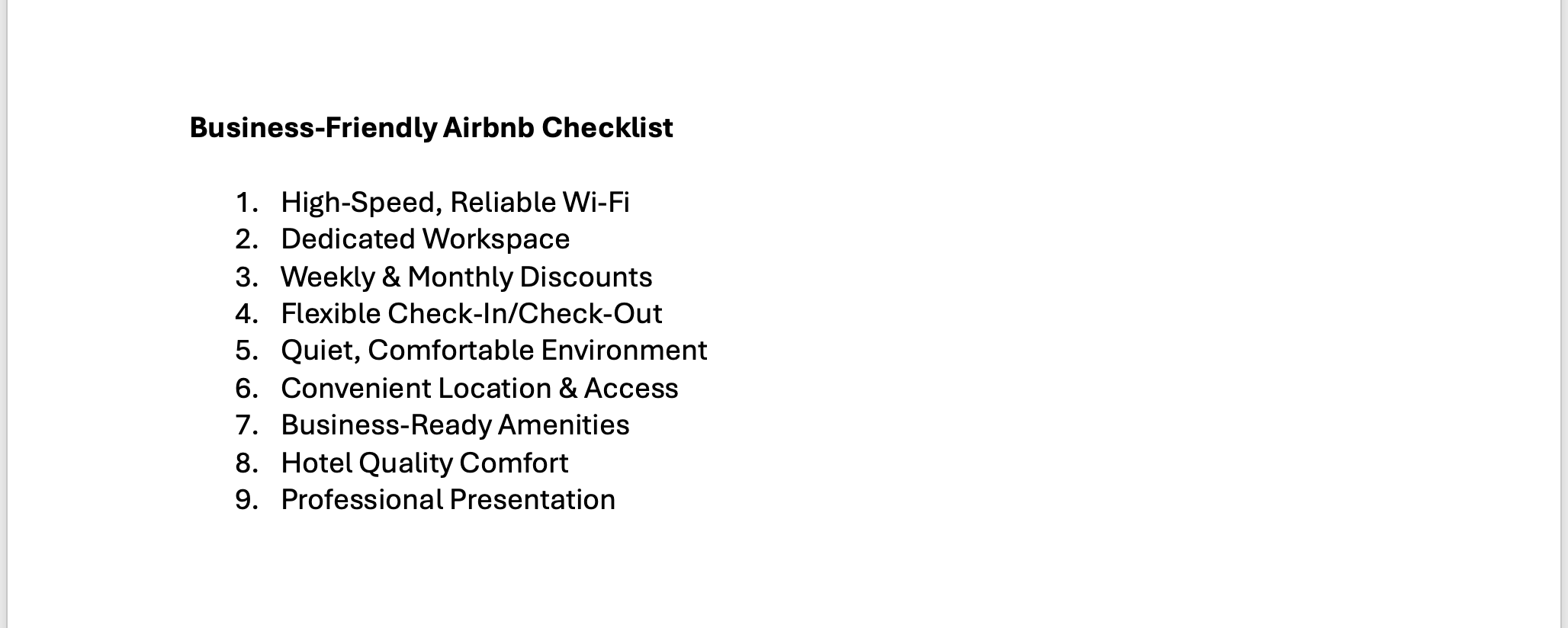
Ensure you meet at least the criteria listed above to accommodate business travelers
When beach towels and selfie sticks disappear for the season, business travelers shine. These guests travel all year, no matter the weather. They don’t seek tiki bars. Instead, they want fast Wi-Fi, a cozy workspace, and a quiet spot to relax after meetings. Adjusting your pricing and amenities can attract road warriors and remote workers. This change can turn your listing into their ideal basecamp.
🔥 Why This Works: Business travelers usually stay longer and book more often. Also, their expenses might be paid with a company card. They care less about price. Instead, they focus on comfort, convenience, and being productive.
✨ Pro Tip: Update your listing title and description. Use phrases like “great for remote work” or “business-friendly features.” Offer mid-week discounts to capture weekday bookings when leisure demand is low. To go further, connect with local businesses, coworking spaces, or conference centers. Building these relationships can bring a steady flow of professionals to you. Corporate goldmine? Activated.
Strategy #20: Lure Early Bookers with Off-Season Early-Bird Discounts
While vacationers rest in the off-season, early planners are busy booking trips. They want to score great deals. Giving a discount to guests who book early helps you get bookings during slow times. It also makes your off-season schedule more predictable. Smart planners grab deals early. With some clever pricing, you’ll catch their eye and ensure consistent income.
🔥 Why This Works: Early bookers provide a crucial advantage—predictability. Encouraging travelers to book early helps you plan for the off-season. This also cuts down on uncertainty during slow months. You can mix this strategy with other discounts. For example, consider monthly rates or weekly promotions.
✨ Pro Tip: Offer a 10-15% early bird discount for guests who book at least 3 months in advance. Use a dynamic pricing tool to automate everything. Also, create urgency by promoting it as a limited-time offer. Watch how this impacts your bookings. An increase in early commitments is your secret weapon for an easier off-season!
Additional Tips & Management Insights
Once you know the main strategies, stay active in improving your method. Airbnb pricing isn’t a “set it and forget it” task. It requires ongoing adjustments and using expert tools to stay ahead. Here are some simple tips to keep your Airbnb pricing competitive.
1. Mark Up Your Prices by 15% to Enable Enticing Discounts
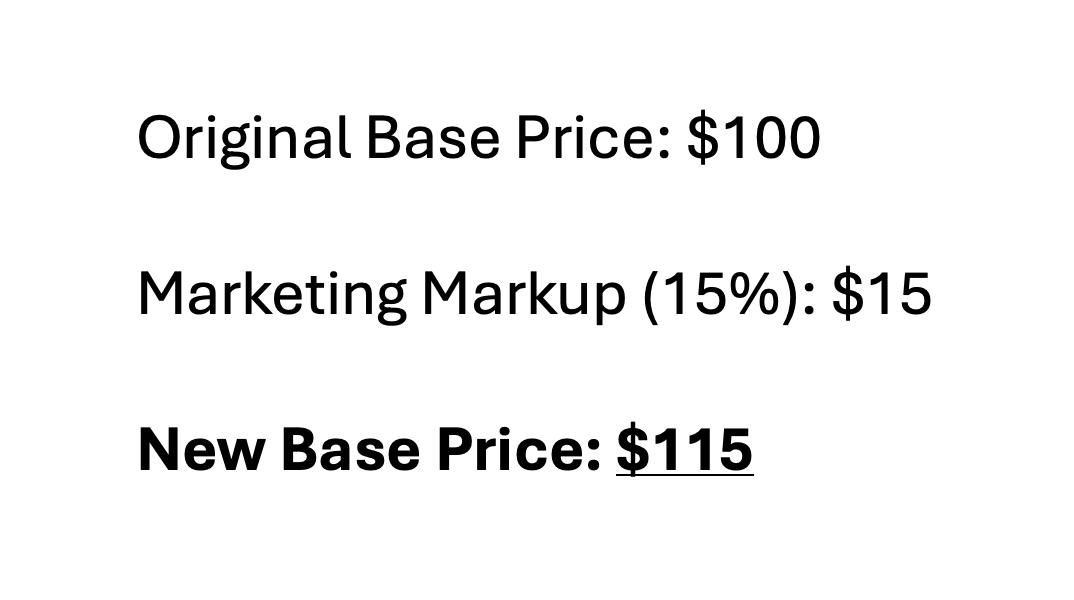
Add a 15% markup to your original base price. This allows you to offer discounts and better market your listing
You may believe that higher prices scare off guests. But a small price hike of about 15% might boost your bookings. Here’s why: When you raise your base price, you can give appealing discounts later. Think about seasonal sales or last-minute offers. This pricing technique takes advantage of psychological pricing—travelers love a good bargain. People see “15% off” or “discounted price” and think they’re getting a deal. This is true, even if the original price was lower. This can greatly increase conversion rates. This is applicable during all seasons or when filling calendar gaps.
The markup lets you make better offers while keeping your profit margin. This way, you’re ready for slow times.
2. How to Manage Your Airbnb Pricing Strategies Weekly
Staying on top of your Airbnb pricing is like managing a stock portfolio—regular reviews are key. Take time each week to check your occupancy rate. Look at competitor pricing, too. Also, look for local events that might affect demand. Are there major festivals coming up? Is your property still priced competitively? By staying proactive, you can make timely adjustments that keep you ahead of the game.
Weekly management lets you make small, steady changes. These changes work better than big price swings. Dynamic pricing software can automate a lot of this process. But remember, spreadsheets are still valuable for tracking changes and results. This helps you create a strong data set. You can refine your strategy each year. It gives you insights into what works and what doesn’t.
3. Benefits of Hiring a Specialized Airbnb Marketing Agency

Contact us today
Hiring a specialized Airbnb marketing agency can transform your business. This is especially true if you have many listings or want to grow. These agencies provide data-driven insights. They use advanced market research tools and industry benchmarks. This helps them adjust your pricing strategy in real time. They track demand fluctuations, competitor rates, and even suggest creative promotional campaigns. It’s not just about pricing. They also manage listing optimization, calendar management, and more. This keeps your property on the radar for guests.
A dedicated marketing agency helps property managers with many listings. They save you time and effort. This way, you can focus on what you do best. Meanwhile, they work to maximize your net income. In competitive markets, expert support can improve your performance. It can also help you find new ways to earn money.
Ready to Unlock Maximum Profit? Let’s Talk!
📩 Message us today! Let’s improve your pricing strategy and make your Airbnb a top income source.
Airbnb Pricing Strategy Recap: Optimize Your Pricing All Year Long
Effective pricing on Airbnb goes beyond just setting a rate. It’s also about changing that rate based on market trends, guest actions, and seasonal changes. No matter how busy or slow, these expert strategies can boost your revenue and fill your schedule with bookings. Use this recap as a checklist. It will help you keep your pricing dynamic, competitive, and profitable.
Advanced Airbnb Pricing Strategies
- Set a Rock-Solid Minimum Acceptable Rate: Establish your bottom line to avoid underpricing. This ensures that even in slower seasons, you’re still earning enough to cover costs and make a profit.
- Use Orphan Gap Pricing to Boost Occupancy: Tackle those awkward gaps between bookings by offering discounts or adjusting rates for short stays. This keeps your calendar full and reduces empty nights.
- Channel-Based Pricing to Attract Direct Bookings: Use different pricing strategies for listings across various platforms. This helps you incentivize direct bookings, cutting out platform fees.
- Day-of-the-Week Pricing Adjustments: Price your listing based on demand fluctuations during the week. Lower prices on weekdays and maintain higher rates on weekends for steady occupancy.
Airbnb Pricing Strategies for Listings with Less Than 10 Reviews
- Undercut Competitors for Initial Traction: When you’re starting out, offering lower rates than nearby competitors helps you attract initial bookings and boost your review count quickly.
- Activate Airbnb Smart Pricing for Increased Visibility: Enable Airbnb’s Smart Pricing tool to automatically adjust your rates based on demand and your listing’s performance.
- Short Minimum Stay to Build Reviews Fast: Keep your minimum stay requirement low to encourage more bookings and get reviews fast. It also helps you generate more social proof to stand out.
- Reduce or Eliminate Cleaning Fees: Attract more guests by removing or lowering cleaning fees, which are often a turn-off, especially for budget-conscious travelers.
- Offer Flexible Cancellation to Encourage Bookings: Offering flexible or moderate cancellation policies can increase your booking rate by reducing guest hesitations.
Advanced Airbnb Pricing Strategies for Peak Season
- Block Your Calendar, Then Release Dates Last-Minute: Temporarily block peak season dates to create scarcity, then release them at higher rates to drive urgency and get premium pricing.
- Gradually Raise Prices as Occupancy Grows: Use incremental price increases as you book up, ensuring you capture the highest possible rate as the calendar fills.
- Capitalize on Premium Weekend & Local Event Surges: Take advantage of local events and weekends by raising your prices during these high-demand periods for maximum profit.
- Enforce Targeted Minimum Stay Requirements: Set longer minimum stays during peak seasons to reduce turnover and maximize revenue per booking.
- Last-Minute Markups to Maximize Gap Nights: If your calendar shows limited availability close to your check-in date, increase your prices to capture last-minute bookers willing to pay more.
- Leverage Early Bird Premiums for Forward-Planners: Offer premium pricing for those who book well in advance during the peak season to secure revenue early and reduce uncertainty.
Advanced Airbnb Pricing Strategies for Off-Season
- Implement Gradual Price Reductions for Slower Demand: Slowly reduce your rates during the off-season to maintain competitiveness while avoiding drastic cuts that hurt your profits.
- Adopt Ultra-Competitive Rates to Stay in the Game: In slower months, adopt aggressive pricing to stay visible and attract budget-conscious travelers. This helps you maintain occupancy during the off-season.
- Extend Weekly and Monthly Discounts: Appeal to long-term guests by offering discounts on extended stays, ensuring steady income with fewer turnovers.
- Cater to Corporate Guests and Business Travelers: Adjust your pricing and amenities to attract business travelers who book for work-related trips, often with flexible budgets and longer stays.
- Lure Early Bookers with Off-Season Early Bird Discounts: Offer discounts for guests who commit to off-season stays early. This secures bookings and stabilizes your income during slower months.
Additional Tips & Management
- Mark Up Your Prices by 15% to Enable Enticing Discounts: Slightly increase your base price (around 15%) to create room for attractive, time-sensitive discounts that still protect your profit margins.
- How to Manage Your Airbnb Pricing Strategies Weekly: Review your pricing and occupancy weekly to ensure you’re adapting to changes in demand. Use automated tools and spreadsheets to track results and refine strategies.
- Benefits of Hiring a Specialized Airbnb Marketing Agency: Agencies can help with dynamic pricing, seasonal strategy execution, and listing optimization, ensuring your property stays competitive while saving you time and effort.
The Bottom Line
Here are 20+ smart Airbnb pricing strategies to stay competitive and increase your income all year.
Start by taking action! Choose a few strategies that fit your market and property, and start right away. You can activate dynamic pricing tools. Set a minimum nightly rate. Also, offer early-bird discounts. These small adjustments can make a big impact on your profitability.
Success on Airbnb comes from consistency and continuous refinement. Keep testing, adjusting, and learning from market trends. A good pricing strategy helps you beat the competition. You’ll see your bookings and revenue increase.
Frequently Asked Questions (FAQ)
Q: What is the best Airbnb pricing strategy for new hosts?
A: New hosts can start strong with low introductory pricing and Airbnb Smart Pricing. It helps get initial bookings and build social proof. Reviews are KEY to establishing credibility on the platform.
Q: Does using Airbnb’s Smart Pricing guarantee more bookings?
A: Not necessarily. Smart Pricing keeps you competitive. Yet, third-party dynamic pricing solutions often do better once you reach 10+ reviews. They look at more data, such as competitor actions and local market needs. This helps you get more profitable bookings.
Q: Should I offer monthly discounts during the off-season?
A: Yes! Monthly discounts help draw in longer stays during slower times. This keeps your occupancy steady. This also lowers turnover costs and keeps your income steady during low demand.
Q: How can I handle different pricing strategies if I manage many properties?
A: Consider using a third-party dynamic pricing tool that can adjust prices for all your listings at once. You can also hire an Airbnb marketing agency. They can simplify things and help you manage your pricing strategies across all your properties.

